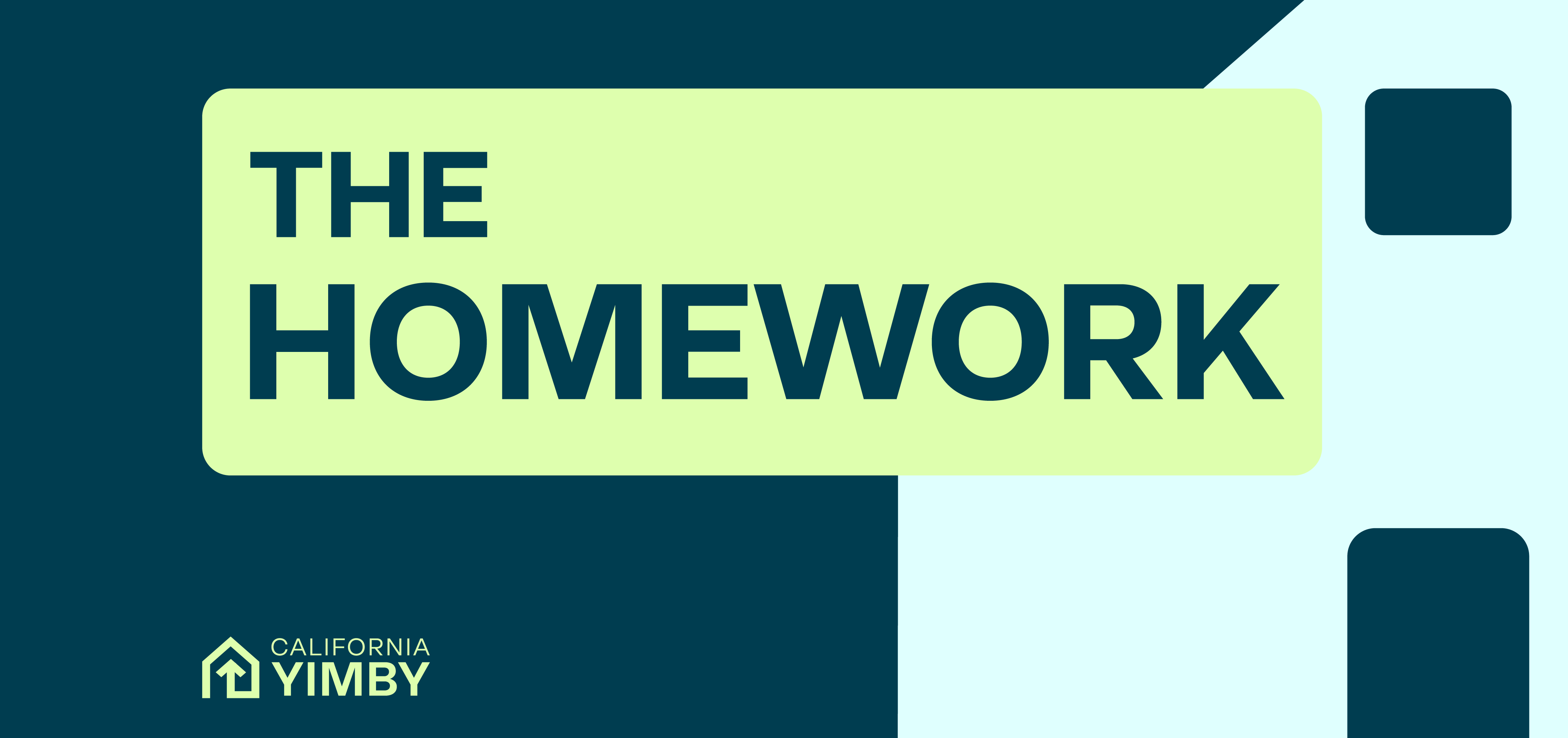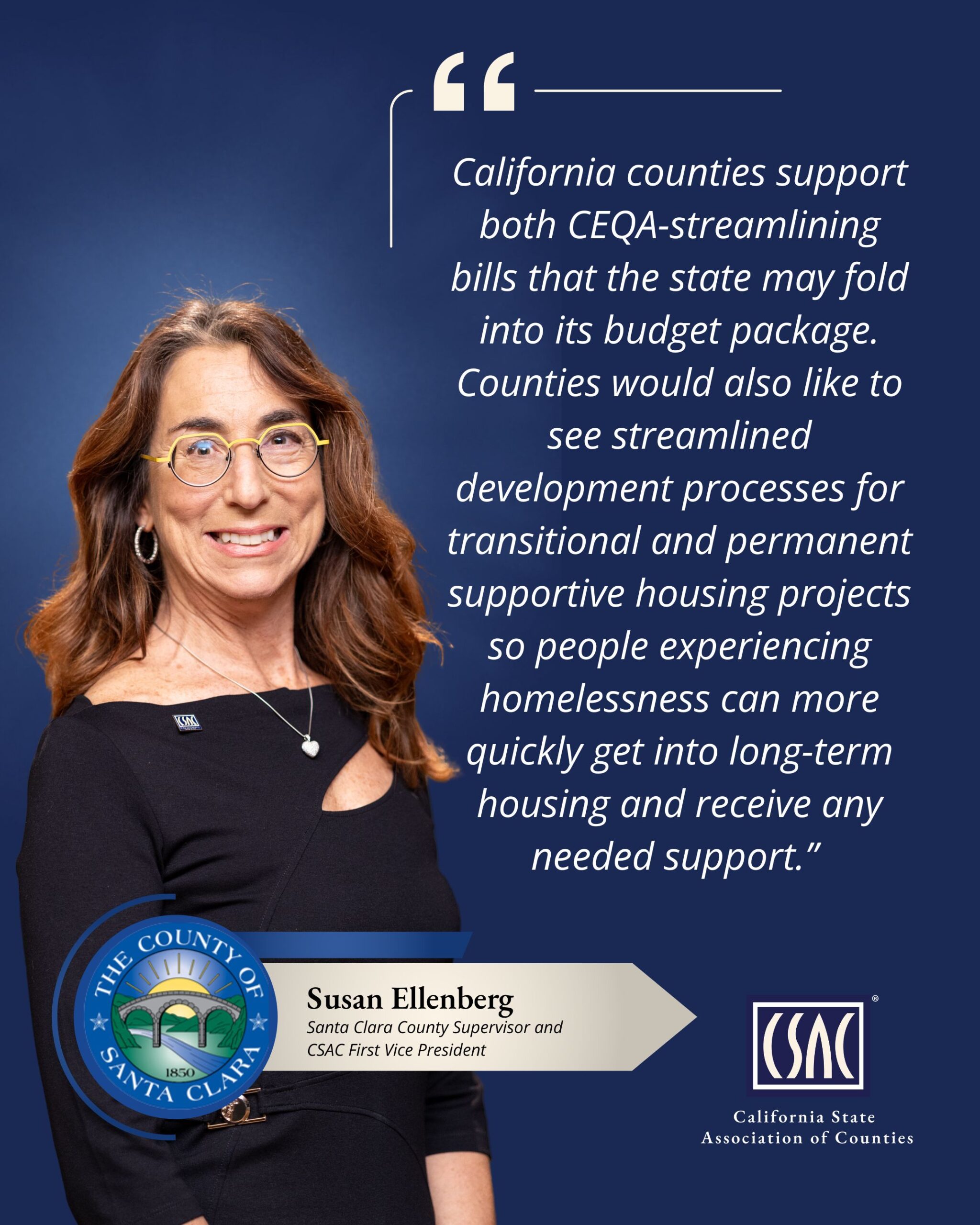The Homework: May 20, 2025

Welcome to the May 20, 2025 Main edition of The Homework, the official newsletter of California YIMBY — legislative updates, news clips, housing research and analysis, and the latest writings from the California YIMBY team.
News from Sacramento
Suspense Week
It’s an annual, high-stakes tradition in Sacramento: Suspense Week. This is the week when all legislative bills (in both chambers) that could have a fiscal impact are put in the “suspense file” prior to being voted on by their respective Appropriations Committee. Bills that advance will be brought to the Assembly and Senate floors; bills that don’t make it are held … in suspense.
The Suspense File hearing is scheduled for Friday, May 23. Several California YIMBY-sponsored bills are currently on suspense, including:
- SB 79 (Wiener): Will make it faster and easier to build multi-family housing near transit stops, like train and rapid bus lines, by making it legal for more homes to be built in these areas, and streamlining existing permit review processes.
- AB 1308 (Hoover): Speeds up the post-entitlement process by requiring building departments to provide estimated timeframes for permit inspections and allowing applicants to contract with private professionals for inspections.
- AB 413 (Fong): Requires the California Department of Housing & Community Development (HCD) to translate key state housing guidelines and handbooks into the non-English languages commonly spoken in California.
- AB 595 (Carrillo): Creates more pathways to affordable homeownership for working families and communities of color by providing tax credits for the construction of for-sale homes affordable to Californians who earn moderate income.
Bills advancing to the Floor: These sponsored bills have either already passed Appropriations or did not carry a fiscal cost–and are now moving forward to the floor:
- AB 609 (Wicks): Creates a CEQA exemption for environmentally-friendly housing located in existing urban areas (“infill housing”).
- AB 1061 (Quirk-Silva): Makes it easier to increase the number of homes—including duplexes—in single-family neighborhoods by allowing the California HOME Act (SB 9, 2021) to be used in historic districts.
- SB 9 (Arreguín): Ensures that local laws governing the construction of accessory dwelling units (ADUs) align with state law, and provides a pathway to eliminate unlawful local barriers to ADUs.
Bills Headed to Senate Committees: The following bills have passed the Assembly floor and are awaiting Senate Committee hearings:
- AB 1154 (Juan Carrillo): Removes owner-occupancy requirements for “junior” ADUs (ADUs built within an existing home) that do not share sanitation facilities with the existing structure. It will also exempt small ADUs under 500 square feet from parking requirements, similar to existing exemption for JADUs.
AB 253 (Ward): Speeds up the approval process for new homes by allowing home builders to hire a licensed and certified third-party reviewer for review of housing permit applications if the local government cannot or does not complete their permit review within 30 days.
Fast-Track Housing Update
Every bill in the Fast-Track Housing packing has passed its policy committees and is now either on the Suspense calendar or headed to a floor vote.
To learn more about the bills, visit the official Fast Track Housing Package website.
To stay current on what housing bills California YIMBY is sponsoring and supporting, you can now use our Abstract link to track with us.
Be sure to stay tuned for future editions of The Homework (and follow California YIMBY’s Twitter and Bluesky channels), to stay current on housing policy research, news, and legislative updates.
Housing Research & Analysis
How housing reform around LA Metro stations could save the city
Los Angeles faces a billion-dollar budget deficit that threatens critical services. One overlooked solution lies in its land use policies: the city prohibits multi-family homes near most of its transit stations, even though taxpayers have invested billions of dollars in improving transit in those locations; a different approach offers win-win-win on both housing and budget deficits – but also offers solutions for climate pollution.
In “Land Use Reform Can Solve the Los Angeles Budget Crisis,” Streets for All researchers Josh Vredevoogd, Joey Shoyer, and Michael Le analyzed property tax data across Los Angeles to quantify how current land use policies affect city finances and what Senate Bill 79’s transit-oriented upzoning could yield in revenue for the city.
Key Takeaways:
- Apartment buildings generate 18 times more property tax per acre than single-unit detached homes ($392,561 vs. $21,711 annually). Yet the city bans new apartments on 45% of residential land near transit.
- Los Angeles has spent billions of public dollars improving its transit systems, but the ongoing apartment bans severely limits ridership to those who live nearby. This also limits transit revenues, and is a de-facto “privatization” of public transit.
- Land use reforms proposed in SB 79 could generate enough property tax revenue to help address the city’s budget crisis, while also bolstering transit ridership and revenues.
How California makes it harder to build homes where people drive less
California lets homebuilders fast-track housing in certain “low-VMT neighborhoods”—areas where new residents are expected to drive less than average (low vehicle miles traveled). The idea: support climate goals and housing access at the same time. But a new report shows the state’s current approach often excludes the places where housing could do the most good.
In UC Berkeley’s Terner Center’s new report, Aligning Housing with Climate Goals: The Importance of Measuring VMT, Rachel Strangeway and Zack Subin investigate how different models of estimating VMT reshape which neighborhoods qualify and what that means for housing, emissions, and equity.
Key Takeaways:
- The state’s current VMT model misses large parts of urban California that are potentially eligible for fast-tracked housing. Another tool, Replica, identifies 62% of Los Angeles residents in low-VMT areas. The State model identifies just 40%.
- The state usually compares neighborhoods to their region’s average VMT. But in already low-driving areas like the Bay Area, this makes it harder for neighborhoods to qualify. Using a statewide average would expand neighborhood eligibility by 40% in the Bay Area.
- Current methods often miss high-opportunity neighborhoods. These are places with good schools, jobs, and services. Other models’ results overlap more with California’s Opportunity Map, while the State model often fails to include them.
Houser Headlines
- Gavin Newsom lays down the law on housing construction – POLITICO
- This rich beachfront city is trying to launch an anti-housing insurgency in California
- Opinion: Don’t let the city kill a successful ADU program building affordable homes
- California wants to lower housing costs by freezing building code – CalMatters
- Denser housing may be on the horizon near LA’s transit centers | LAist
- California Assembly moves forward with major proposal to help the state’s housing crisis
- Newsom picks more housing over CEQA in backing two bills meant to speed construction
- The Home Insurance Crisis Is Getting Even More Expensive – The New York Times
- Multifamily housing in California costs twice as much to build than in Texas
- SPUR Briefs Press on Transit’s Looming Financial Meltdown
YIMBY Social – Top Posts

Share the good word
We welcome your ideas and feedback — send story tips and ideas to Homework@cayimby.org.